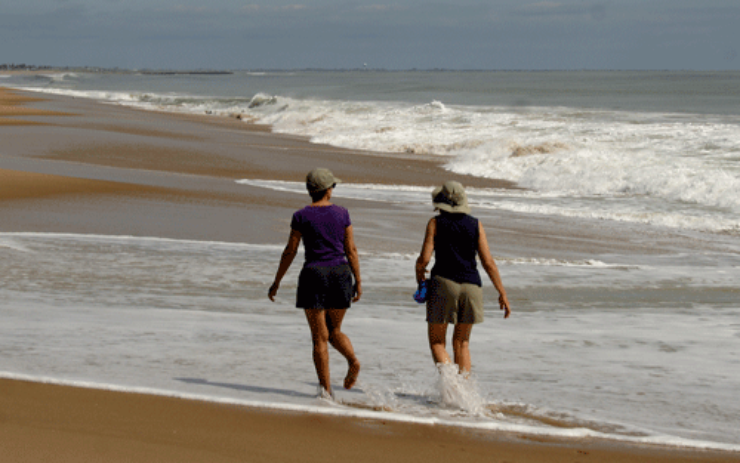RI Shoreline Access Bill Passes House And Senate
UPDATE: Governor McKee signed the RI Shoreline Access Bill into law on June 26.
On June 15, a compromise bill to assure shoreline access passed the Rhode Island House and Senate. It only awaits the Governor’s signature to become law.
The bill that passed, S 417, was sponsored by Charlestown’s Senator, Victoria Gu, and others.
Article I, Section 17 of the Rhode Island Constitution gives all the people the right to walk along the shore and other privileges:
The people shall continue to enjoy and freely exercise all the rights of fishery, and the privileges of the shore, to which they have been heretofore entitled under the charter and usages of this state, including but not limited to fishing from the shore, the gathering of seaweed, leaving the shore to swim in the sea and passage along the shore”
Rhode Islanders’ rights to the shore are clear, but what was less clear is where exactly you get to enjoy those rights. To answer these questions a study commission was established in 2021 and headed by Middletown Representative Terri Cortvriend and then Charlestown Representative Blake Filippi to study and provide recommendations on the issues relating to lateral access along the Rhode Island shoreline.
In June 2022 the Shoreline Access bill, authored by Charlestown’s former Representative Blake Filippi, along with Representatives Cortvriend, Craven, and others passed the RI House unanimously in a 65-0 vote. The Senate version of the bill, however, stalled in the RI Senate and never came up for a vote.
The 2022 bill was written after the state’s study commission on shoreline access reached a consensus that people should be able to travel along Rhode Island’s shores 10 feet landward from the seaweed line. During the House deliberations, the 10-foot line was reduced to 6 feet.
On January 19, 2023, Representative Terri Cortvriend along with Charlestown’s current Representative Tina Spears, Representative Craven, and others reintroduced the same bill language that passed the House in 2022.
In February 2023 the Senate version was introduced with a 10-foot space from the seaweed line. There was a substitute bill that passed and that is the bill that both legislative bodies ultimately passed.
From the explanation in the act that passed:
This act would provide that the public’s rights and privileges of the shore established by Article I, Sections 16 and 17 of the State Constitution may be exercised where shore exists, on wet or dry sand or rocky beach up to ten feet (10′) landward of the high tide line but not where no passable shore exists with abutting landowners afforded limited liability.”
More specifically, “the public’s rights and privileges of the shore shall not be afforded where no passable shore exists, nor on land above the vegetation line, or on lawns, rocky cliffs, sea walls, or other legally constructed shoreline infrastructure. Further, no entitlement is hereby created for the public to use amenities privately owned by other persons or entities, including, but not limited to: cabanas, decks, and beach chairs.”
The bill also contains an educational directive. The RI Coastal Resources Management Council and the RI Department of Environmental Management (DEM) are charged to “develop and disseminate information to educate the public and property owners about the rights” described in the new law. CRMC, DEM, and the Attorney General are also responsible to “determine appropriate language and signage details for use at shoreline locations.”
Charlestown’s former Representative Blake Filippi along with current Representative Tina Spears and Senator Victoria Gu deserve our gratitude for their hard work in the legislature to get this legislation passed. Blake Filippi and all the other members of the 2021 study commission along with many citizen volunteers deserve special thanks for their impressive work to build the strong multi-stakeholder consensus in favor of shoreline access that laid the groundwork for the new law.

You can learn more about the author, Ruth Platner, at her profile page.

September 29, 2023 @ 9:19 am
Does this bill change Rhode Island General Law and if so what chapter?
September 29, 2023 @ 9:36 am
Yes it does. It changes WATERS AND NAVIGATION — COASTAL RESOURCES MANAGEMENT
COUNCIL That is 46-23 http://webserver.rilegislature.gov//Statutes/TITLE46/46-23/INDEX.htm
It adds 46-23-26. “The public’s rights and privileges of the shore.” It is not showing yet in the legislatures webserver. But the bill did pass and was signed by the Governor.
August 18, 2023 @ 11:14 pm
Does this mean there are no fully private beaches in RI anymore? Can you go to any beach, even private ones, as long as you stay within 10 feet of the shore line?
August 19, 2023 @ 6:42 am
Yes and no. This is lateral access, meaning along the shore. If you can access the beach in a public spot, then you can walk along the shore and access parts of the beach that have private parking or private roads, etc. The beach itself is public along the water and ten feet above the seaweed line or the wet sand if there is no seaweed line. Please note the quote above “the public’s rights and privileges of the shore shall not be afforded where no passable shore exists, nor on land above the vegetation line, or on lawns, rocky cliffs, sea walls, or other legally constructed shoreline infrastructure.” So from a fully public beach, you can walk along the shore to what is a private access beach and then as long as you stay below the 10 foot line you can swim, sit, etc. The entire beach is not public, but the 10 foot swath above the seaweed line and to the water is public. This new law is being challenged by some beach front owners.
June 28, 2023 @ 9:47 am
So for homeowners who have private beach rights, if I understand this correctly the 10’ give people to walk along shoreline but they CANNOT put their chairs or seating in front of private homes. Pls clarify.
June 28, 2023 @ 10:06 am
I believe the authors of the bill would say that the RI Constitution defines what you can do at the shore, and that this legislation defines only where you can do it. The constitution language is the first quoted section above. What this legislation says about chairs is that the public has no right to use your chairs or equipment etc., even if you have put them within that 10 feet. The constitution does not mention chairs, but it does mention fishing and swimming, “including but not limited to fishing from the shore, the gathering of seaweed, leaving the shore to swim in the sea and passage along the shore”. That “including but not limited to” may be argued over by lawyers. My understanding is that both the study commission and the legislation only addressed the “where”. This will all probably be more clear once the CRMC creates the educational materials.
June 26, 2023 @ 11:04 am
Does this bill mention salt water ponds that are fed by the ocean, ie: Potter Pond ?
June 23, 2023 @ 12:10 pm
95%of the time there’s no seaweed on charlestown beach . It only appears after certain storms so that’s ridiculous .. 10 feet from the waters edge is the only thing that makes sense.. also the term “other privileges of the shore ” is perfect for any interpretation (extremely unclear) great for arguments …. I’ve lived on the beach for the last 37 years.
June 24, 2023 @ 10:21 am
There is some language in the bill to address the lack of seaweed, “in the absence of residue seaweed or other evidence, the recognizable high tide line means the wet line on a sandy or rocky beach.” A link to the full legislation is at the top of the post.
June 19, 2023 @ 4:16 am
Now that the parameters for shoreline access have been set down, will the State provide detailed maps depicting where the line exists. This would be easily achieved with Aerial Photography and GIS technologies and could make it easier for all parties concerned. Without a good set of maps and current data, everything is changeable. It would put meaning into the cliche “to draw a line in the sand.”
June 19, 2023 @ 9:49 pm
The line will shift. Ten feet landward from the wrack or seaweed line. All you have to do is look down!
July 8, 2023 @ 8:55 am
It’s easy to tell where the line is